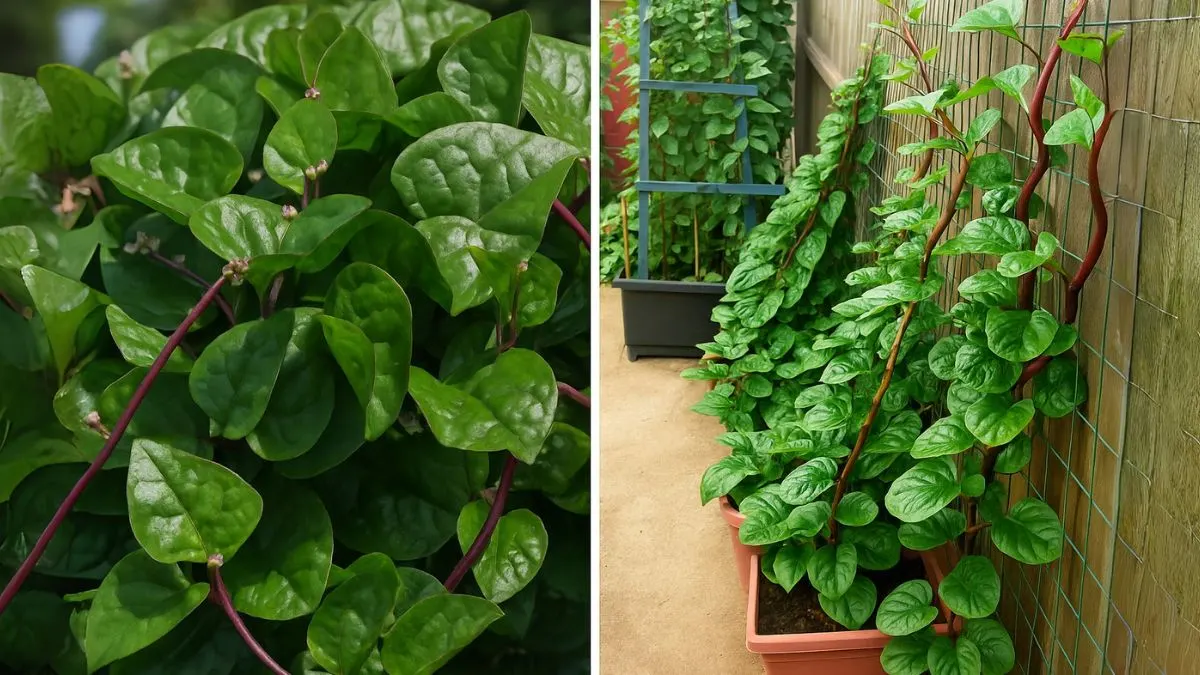If you’ve ever wished your spinach could last all year long, meet Malabar Spinach (Basella alba). Unlike the delicate leafy greens we often grow in cooler months, this plant thrives when the weather is hot. It’s not just another vegetable; it’s a perennial edible vine that can grow for years with minimal effort.
In fact, the first time I grew it on my balcony, I was amazed to see how quickly it climbed up a trellis and how beautiful its glossy, heart-shaped leaves looked. More than just eye candy, it became my go-to for quick salads, stir-fries, and smoothies.
What Makes Malabar Spinach Special?

1. A Perennial Edible
Unlike typical spinach, which bolts in summer heat, Malabar Spinach (Basella alba) flourishes in warm, humid conditions. It’s called a perennial edible because once established, it can keep producing year after year in frost-free zones. Even in colder regions like Canada, you can grow it in containers and bring it indoors during winter.
2. Nutritional Value
This leafy green is packed with vitamins A and C, calcium, magnesium, and iron. Its texture is slightly mucilaginous (similar to okra), which makes it excellent for soups and curries. Nutritionally, it stands alongside powerhouse greens like kale, spinach, and microgreens.
How to Grow Malabar Spinach
Ideal Growing Conditions
- Light: Loves full sun but can tolerate partial shade.
- Soil: Rich, loamy, and well-drained with consistent moisture.
- Watering: Keep the soil evenly moist, but never waterlogged.
If you’re growing in Canada or the northern USA, start seeds indoors in spring and transplant once frost danger has passed. In warmer climates, direct sowing works perfectly.
Planting Steps
- Soak seeds overnight to soften their hard coats.
- Plant them ½ inch deep in fertile soil.
- Space vines about 12 inches apart.
- Provide a strong trellis or support—they can grow up to 10 feet tall!
Within weeks, you’ll see lush vines ready to climb.
Malabar Spinach vs. Regular Spinach
Feature |
Malabar Spinach |
Regular Spinach |
Climate Preference |
Hot & humid |
Cool weather |
Growth Habit |
Perennial vine |
Annual plant |
Nutritional Value |
Similar to kale, spinach, and microgreens |
High in iron & vitamins |
Lifespan |
Several years |
Few months |
This comparison shows why many gardeners prefer adding Malabar Spinach to their edible landscape.
Ways to Enjoy Malabar Spinach
- Fresh in Salads: The tender young leaves have a crisp texture, making them perfect for salads. They add a unique, slightly peppery flavor.
- Stir-fries and Curries: The thicker leaves hold up beautifully when cooked. In Asian cuisine, they’re often stir-fried with garlic and chili.
- Soups and Smoothies: Because of their slight mucilaginous quality, the leaves help thicken soups naturally. Blended into smoothies, they add nutrition without overpowering taste.
Why Gardeners in the USA and Canada Love It
For gardeners in North America, Malabar Spinach (Basella alba) is an exciting alternative to regular greens. While spinach struggles in summer, this vine keeps producing lush, edible leaves. Many home gardeners appreciate its ornamental look too—it’s both a food source and a natural decoration.
I remember visiting a friend in Toronto who had trained hers around a balcony railing. Guests thought it was purely ornamental until they tasted a salad made from the glossy leaves!
Care Tips for Success
- Harvest regularly to encourage new growth.
- Mulch the soil to retain moisture.
- In cold regions, grow in pots so you can bring the plants indoors.
Growing Malabar Spinach (Basella alba) is like having the best of both worlds—a beautiful vine and a perennial edible that nourishes your family. It’s hardy, nutritious, and versatile, standing shoulder to shoulder with kale, spinach, and microgreens in terms of health benefits.
Whether you’re in the USA, Canada, or anywhere else in the world, this plant deserves a spot in your garden. Not only will it fill your plates, but it will also fill your home with greenery and life.
So why not try it this season? Once you taste its fresh leaves, you’ll never look at regular spinach the same way again.






